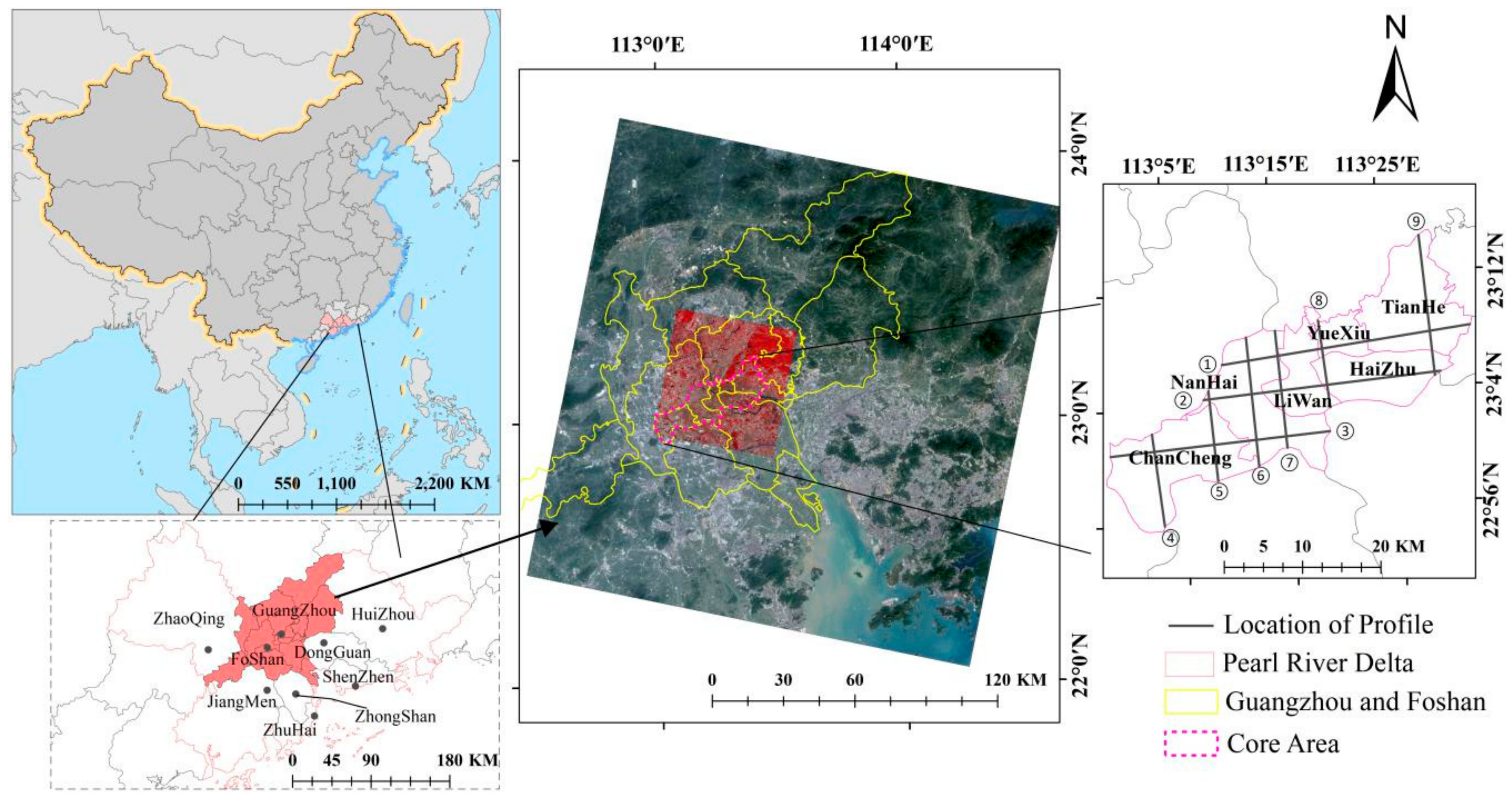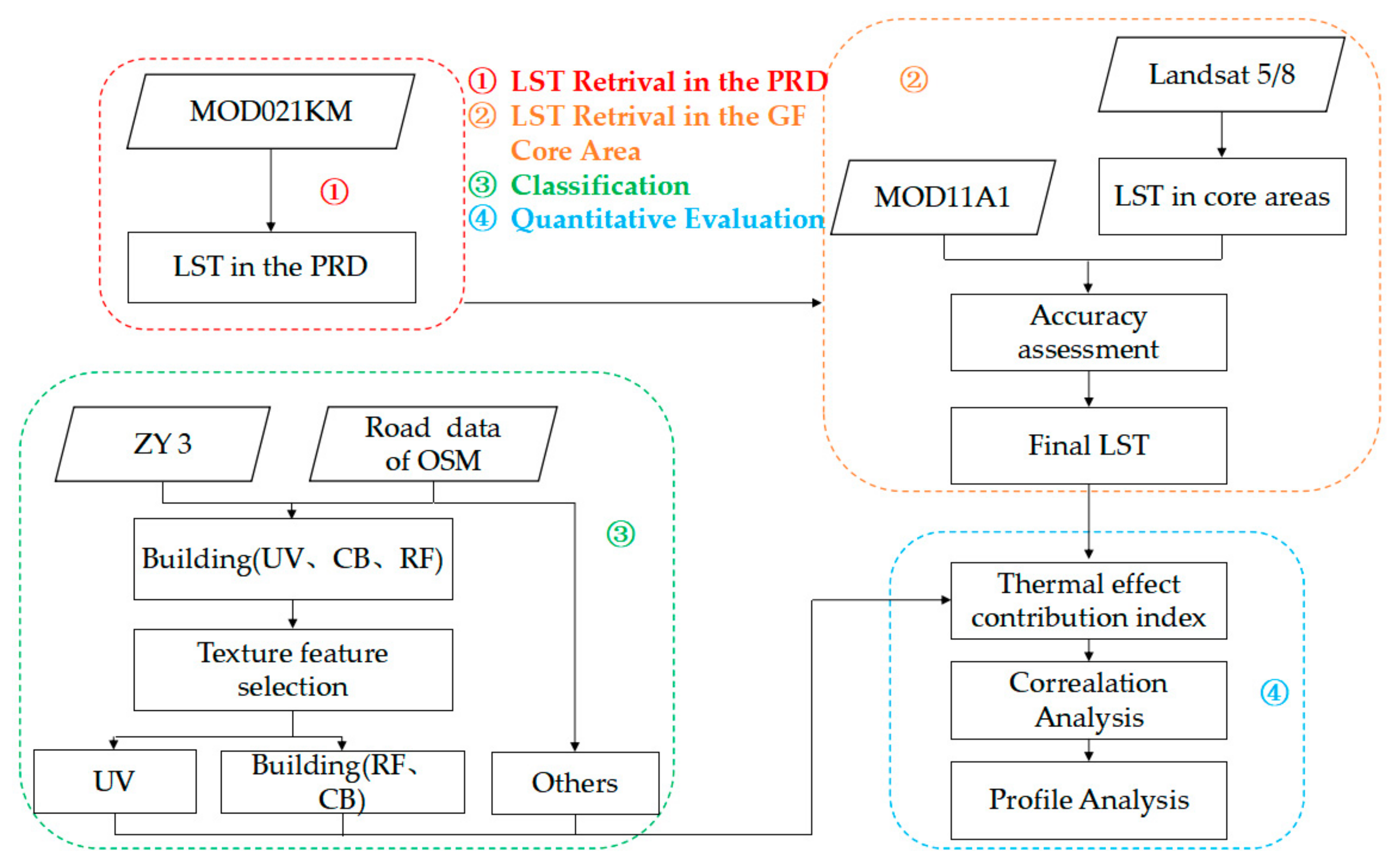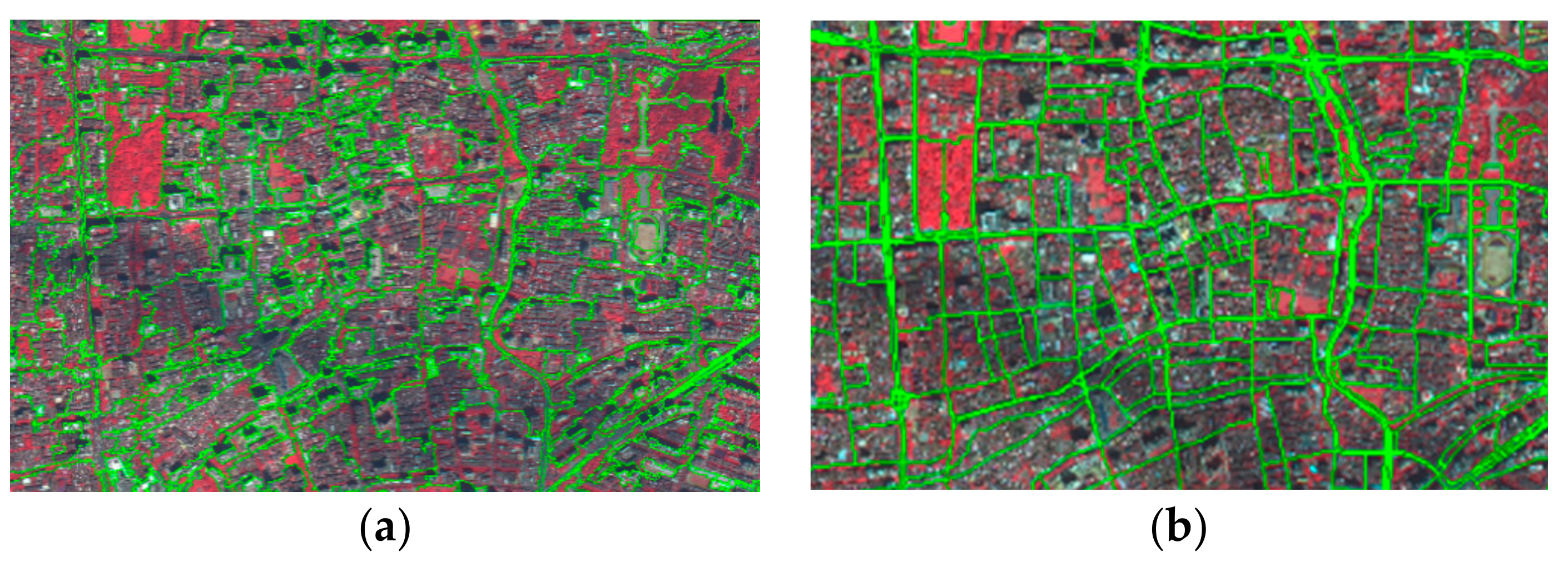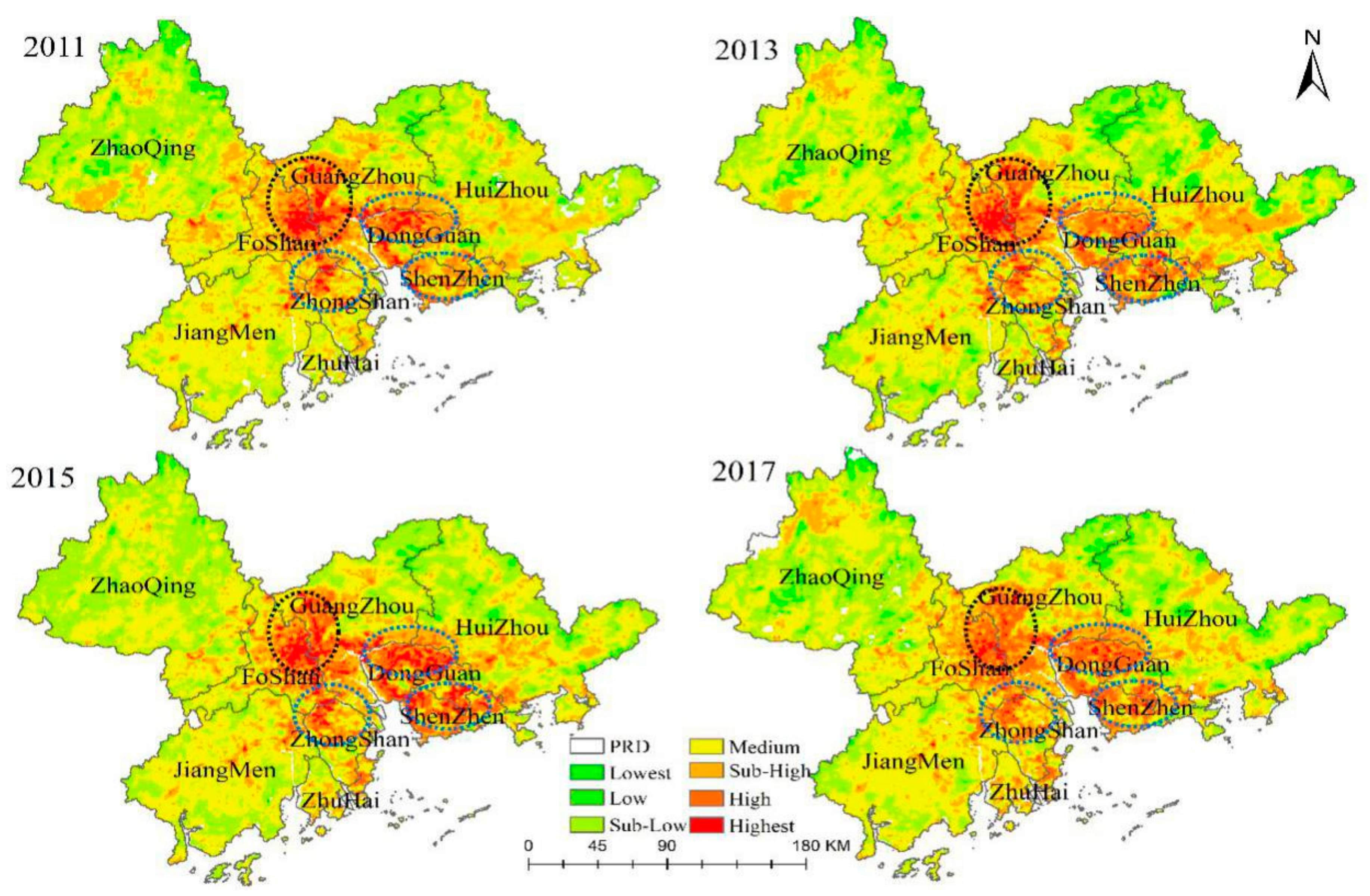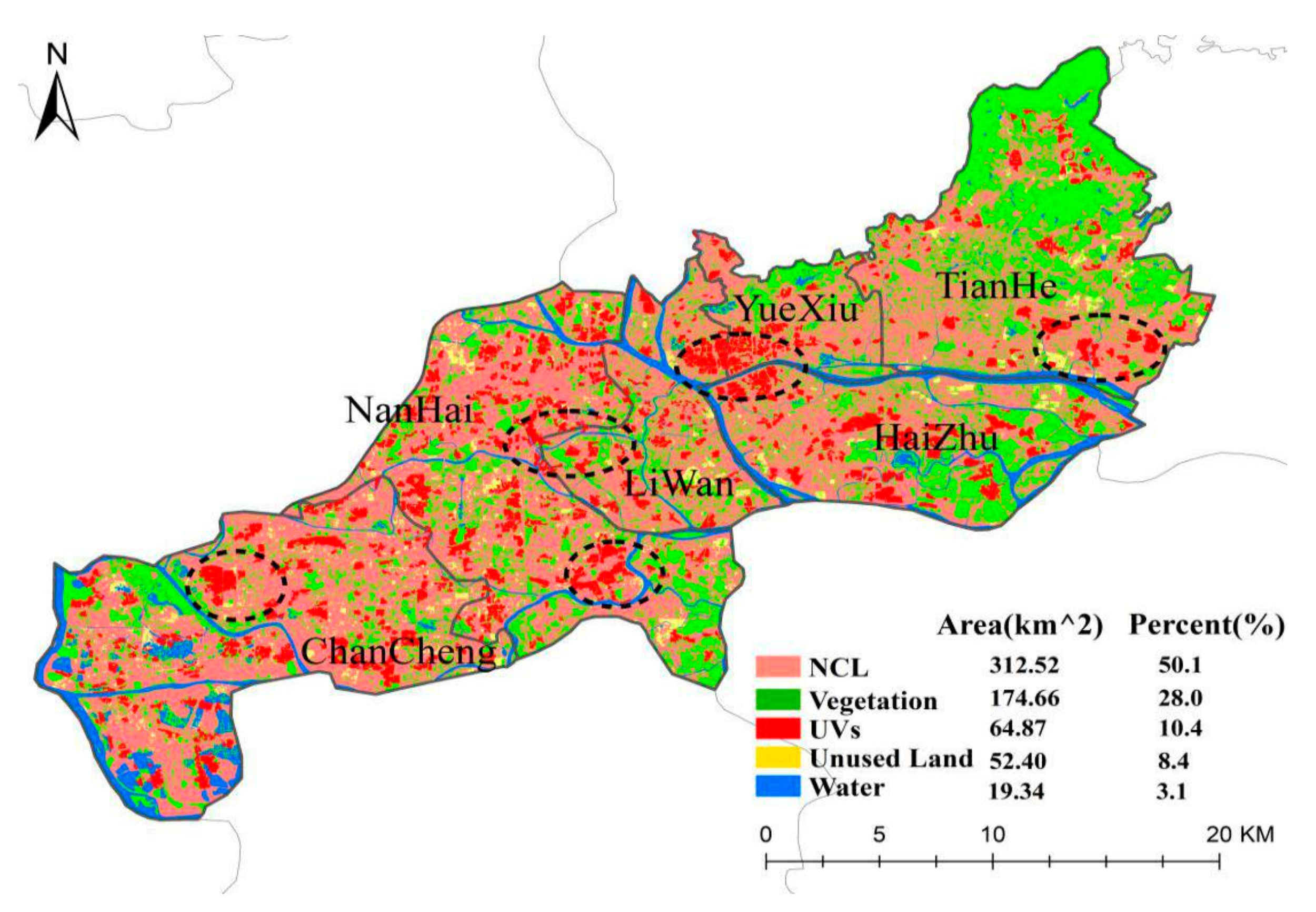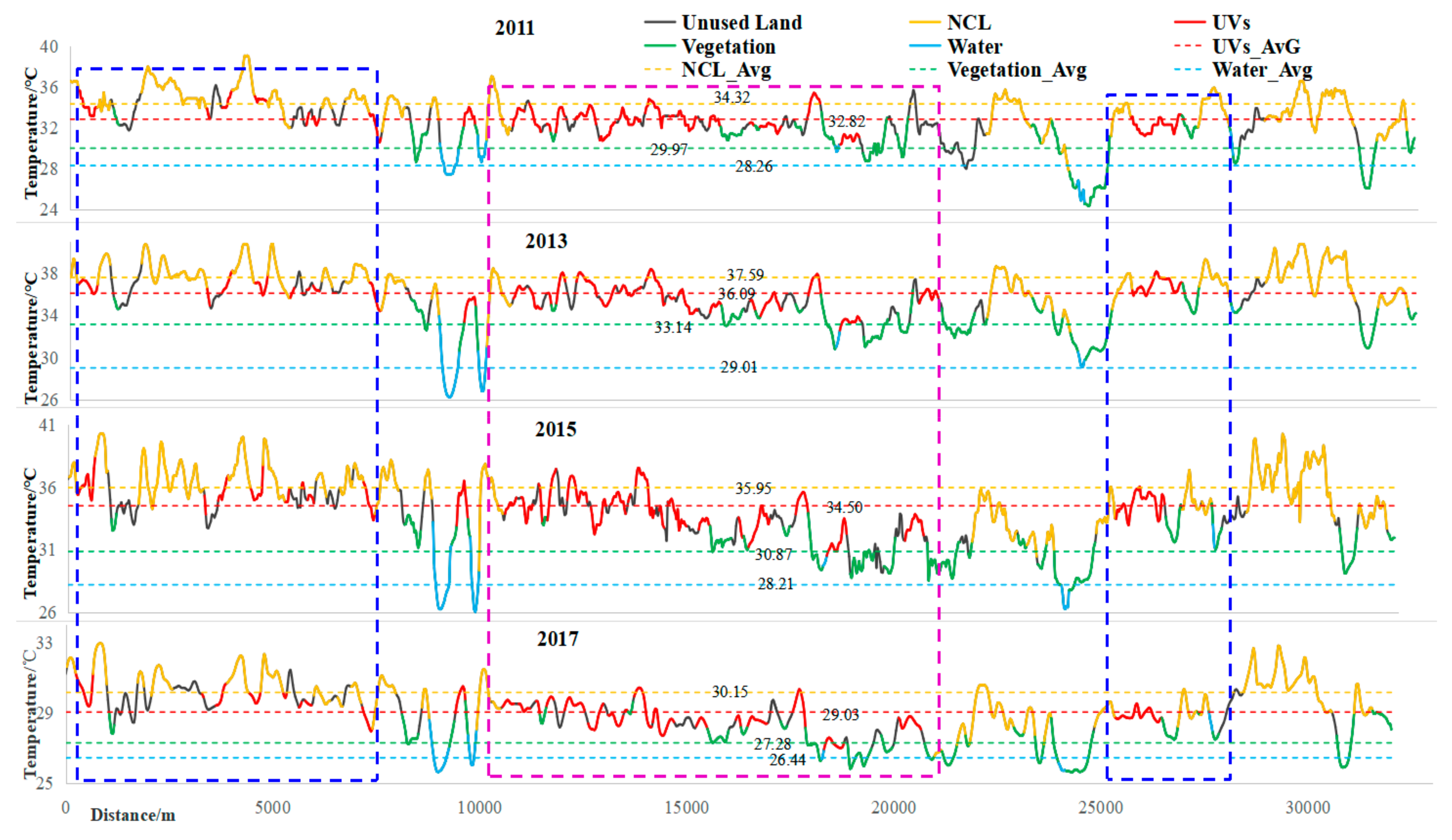1. Introduction
In recent years, rapid urbanization leads to temperature rise in cities all around the world, forming an urban heat island (UHI). In addition to thermal discomfort, urbanization in the developing world often leads to the problem of informal settlements (e.g., urban villages (UVs) and slums) [
1,
2,
3,
4]. However, the relationships between these informal urban settlements and abnormal urban thermal environment remain little understood.
Dramatic transformations and reconstruction of urban space were induced by the living and production demands of ever increasing population during the rapid urbanization. A large number of rural villages on edges of cities can become engulfed, leaving the rural settlements intact and scattered throughout the urban area [
2,
5,
6,
7,
8]. The development of UVs is neither authorized nor scientifically planned. As a result, UVs are commonly featured by small and dense substandard buildings, absent vegetation coverage, poor sanitary conditions, overcrowded population, and environment pollution [
9,
10], which attract increasing attention from local urban planners and policymakers who concentrate on the urban renewal and better living environment.
The UHIs are defined by the temperature differences between urban areas and suburban/rural areas [
11,
12,
13,
14,
15]. Urbanization leads to the transformation of natural landscapes, such as vegetation, water bodies, and agrarian lands, into impervious surfaces, such as construction land. This transformation reduces vegetation evapotranspiration, increases solar radiation absorption, influences the local and regional climate, and gives rise to the UHI [
16]. The UHI can be evaluated with air and surface temperatures. The studies of UHI based on air temperatures were mainly to evaluate the intensity of heat islands [
17] and simulate the urban temperatures using the Weather Research and Forecasting model [
18,
19] or Met office Unified model [
20]. However, air temperature data are obtained from meteorological stations, and their sparse distribution makes a spatially continuous analysis difficult [
21]. Therefore, numerous studies of UHI have been mainly analyzed based on land surface temperature (LST), which can be derived from thermal infrared bands from Landsat [
22,
23,
24], Moderate Resolution Imaging Spectroradiometer (MODIS) [
25] or Advanced Spaceborne Thermal Emission and Reflection Radiometer (ASTER) [
26].
The relationship between LST and land use/land cover (LULC) has been a recent research hotspot, which can provide a scientific basis for urban planning and the regulation of regional environment. Numerous studies have shown that the spatiotemporal patterns of UHIs were influenced to various degrees by different land-use types [
22,
27,
28]. Among them, the construction land makes the largest contribution to the UHI effect, while forest land, farmland, parks, and water bodies tend to mitigate the UHI effect [
29,
30,
31]. However, UVs are seldom considered as a separate category from construction land to quantitatively analyze the effect of UVs on UHIs. The main reason is that the mapping of UVs is difficult indeed because unplanned development leads to complex spectral and spatiotemporal patterns [
10]. Recently, a few studies of informal settlements in developing countries have used high-resolution remotely sensed data to detect it. Hofmann et al. [
8] and Rhinane et al. [
32] used an object-oriented approach to detect informal settlements and the precision of the classification was satisfactory. Owen and Wong [
33] proposed to detect informal settlements with spectral, texture, geomorphology and road accessibility metrics, and indicated that roads and texture play a key role in depicting the differences between informal and formal settlements.
In this study, we perform to detect UVs based on the object-oriented classification method with spectral, texture, shape metrics using ZY-3 high-resolution remotely sensed imagery and road data. Moreover, we investigate the spatiotemporal patterns of UHIs in the core areas of Guangzhou–Foshan (GF) metropolitan area in the Pearl River Delta (PRD) region, using LST data retrieved from Landsat thermal bands, and explore the contribution of UVs to the UHI effect on the multiple scales. This study would provide support for dynamically monitoring the ecological effect of UVs, and preventing some UVs-related public health risk and the regulation of regional environment.
2. Study Areas and Data
The PRD, with the GF metropolitan area as the central region, located in Southern China (21°27′–23°56′ N, 111°59′–115°26′ E), covers a total area of 44,700 square kilometers (
Figure 1). It has a marine subtropical monsoon climate, an annual average temperature of 20–22 °C, and an annual rainfall of 1720 mm, with rain and higher temperatures occurring during the same summer period. In 2017, the gross domestic product of the PRD region reached one trillion dollars, and the permanent resident population reached 59.98 million at the end of that year [
34]. The PRD, in particular the GF region, has a large number of UVs during the rapid urbanization over the past decades. For example, Guangzhou City has 138 UVs, while Shenzhen has more than 1000, with 200 within the Special Economic Zone [
35].
Table 1 outlines the data employed for this study. Before retrieving LST, radiation calibration was performed on the MODIS data, along with geometric correction and cropping of the imagery. For the Landsat 5/8 data (
Appendix A), radiometric calibration and Fast Line-of-sight Atmospheric Analysis of Spectral Hypercubes (FLAASH) atmospheric correction were performed. We used ZY-3 satellite data to obtain land-use type data including that of the UVs in the core areas of GF. This data set includes multispectral and panchromatic images with spatial resolutions of 5.8 m and 2.1 m, respectively. Prior to extraction, we performed geometric corrections and orthorectifications, as well as fusion processing of multispectral and panchromatic images by Pan Sharpening. In addition, road data from Open Street Map (OSM) were used as ancillary data to extract land-use types.
3. Methods
As shown in
Figure 2, the data-processing procedure involved in this paper mainly includes: (1) retrieve LST based on MODIS data as well as UHI spatial pattern analysis of the PRD region; (2) retrieve LST from Landsat-5 thematic mapper (TM) and Landsat-8 thermal infrared sensor (TIRS), and UHI spatial pattern analysis in typical UHI core areas of PRD; (3) extract UVs and other land-use types in typical UHI core areas; and (4) analyze contribution difference of UVs and other land-use types to UHIs. Among them, (1) and (2) relate to retrieval of LST using remote sensing images. We first performed LST retrieval and UHI spatial pattern analysis of the PRD region using remotely sensed imagery with a spatial resolution of 1 km. We also selected a typical UHI core area of PRD (i.e., core areas of GF) and performed LST retrieval and UHI spatial pattern analysis using remote sensing images with a higher spatial resolution (30 m). Then, we extracted land-use type data from high-resolution remotely sensed imagery for the selected areas (step 3). Finally, we comprehensively analyzed the influence and contribution of each land-use type in the selected areas, especially UVs, to the regional UHI. These procedures will be further described below.
3.1. Land Surface Temperature Retrieval from Thermal Infrared Data
As mentioned above, this paper discusses two levels of LST retrieval.
- (1)
LST retrieval in the PRD region. We retrieved LST of the entire PRD region from MODIS thermal infrared bands with a resolution of 1 km and based on a split window 1 (SW1) algorithm [
36]. First, we extracted the 31st, 32nd, 1st, 2nd, and 19th bands of the PRD region. Second, we employed the SW1 method to retrieve LST on 22 September 2011, 11 October 2013, 18 October 2015, and 23 October 2017, respectively. During this process, we adopted estimated brightness temperature, surface emissivity, and atmospheric transmittance. On this basis, due to the errors caused by time phase, we used the standard deviation classification method to eliminate the influence of errors on LST spatial pattern change [
37]. The LST was classified into seven categories: lowest, low, sub-low, medium, sub-high, high, and highest temperatures. The zones with the highest, high, and sub-high temperatures were considered as UHI zones. Meanwhile, this study introduced the urban heat island ration index (URI) [
38]. The URI was described as shown in Equation (1), where
m is the normalization level index;
i is the temperature level of urban areas higher than that of the suburb;
n is the number of temperature levels of urban areas higher than that of the suburb;
w is the weight value, which is the level of the
ith level; and
p is the percentage of the
ith level.
- (2)
LST retrieval of the typical UHI area. We retrieved LST of typical UHI area from Landsat thermal infrared bands with a resolution of 30 m (Landsat-5 TM and Landsat-8 TIRS), using different algorithms. First, we used the radiative transfer equation (RT), single channel method (SC) [
39], and mono-window algorithm (MW) [
40] to retrieve surface temperature from Landsat-5 TM data acquired on 21 September 2011; for the Landsat-8 TIRS data acquired on 18 October 2015, we added a split-window 2 (SW2) algorithm [
41]. Because no actually measured data for the surface temperature were used, we adopted the data in the same period of MODIS LST products to verify the retrieval results, in order to select an appropriate retrieval algorithm for Landsat-8 data acquired on 12 October 2013 and 23 October 2017.
3.2. Extraction of Land-Use Types
According to the spatiotemporal pattern of UHI within the PRD region, a typical UHI area is to be selected for extracting land-use type information. The proposed method includes three parts, which are described successively. All analyses were conducted using eCognition Developer 8.7 (Trimble, Trappentreustr, München, Germany).
3.2.1. Multi-Scale Segmentation of Images Combined with OSM Road Data
Multi-scale segmentation is a bottom-up method that combines adjacent pixels or small-segmented objects to ensure the minimum average heterogeneity exists between the objects and maximum homogeneity exists between intra-object pixels, in order to achieve image segmentation based on local fusion. The segmentation scale range was set to be 290. Considering the high concentration of buildings in UVs, the shape factor was set to 0.5, and the smoothness and compactness weights were 0.5. UVs appeared spatially as blocks divided by road networks. In this study, we added adaptive auxiliary data (e.g., OSM road data) in the segmentation process to make it possible to highlight the distinguishing features of the ground objects, while retaining the auxiliary data’s adaptability to the spatial characteristics of UVs (
Figure 3).
3.2.2. Extraction of Land-Use Types Based on the Nearest Neighbor Method
Before adopting the nearest neighbor classification method, it is necessary to establish the spectral, spatial, and textural rules of each land-use type.
First, we considered both the spectral and shape features. Among the nine features initially selected, seven were spectral features and inversion indicators, including four multispectral bands (blue, green, red, near-infrared indicators), brightness, maximum difference scaling and normalized difference vegetation index (NDVI); two were object shape features, which were the shape index and length/width. Based on the classification sample and classification system, we optimized these features. Based on the optimal feature dimensions, we calculated the degree of separation of each feature dimension for different object types, and performed a preliminary classification, where we divided the land-use types into buildings (e.g., UVs, conventional buildings (CBs), and roofs of factories (RFs)), road, unused land, vegetation, and water.
In addition, we used the gray-level co-occurrence matrix (GLCM) method to extract the texture features of UVs [
42,
43] to supplement the spectral and shape features to extract UVs from buildings. The GLCM method describes precise textures by analyzing the spatial correlation of gray scales with high computational efficiency. Therefore, based on the preliminary classification of buildings, we collected 30 samples, ten each for UVs, CBs, and RFs (
Figure 4).
To improve the efficiency of UV extraction, we performed
t-test to compare the differences in eight textures in UVs, CBs, and RFs (
Table 2). From the
t-test results, we can see that the contrast, dissimilarity, StdDev, and mean textures of UV were not significantly different from those of other objects. Therefore, we excluded these four textures. We selected the remaining four textures as alternatives: homogeneity 90°, angular second moment (Ang. 2nd moment) 45°, entropy 90°, and correlation 90°.
Finally, based on the feature space optimization tool of eCognition Developer 8.7, we selected four textures, four spectral bands, and two feature shapes to optimize the feature selection. According to the feature differentiation index, we obtained the optimal feature dimensions and further divided the buildings into UVs, CBs, and RFs.
3.2.3. Accuracy Verification
This paper selected 531 verification sample points by referring to Google Earth imagery and the random point selection methods, and used the Training and Test Area (TTA) Mask file and confusion matrix analysis methods of eCognition Developer 8.7 to evaluate the extraction accuracy of land-use type data. The kappa coefficient and producer’s accuracy/user’s accuracy were computed for the assessment. The producer’s/user’s accuracy is the ratio of the number of correctly classified samples to the number of reference/classification samples. The kappa coefficient was written as shown in Equation (2):
where
r is the number of rows in the confusion matrix of classification;
is the number of along the diagonal;
is the total number of row
i;
is the total number of column
i; and
N is the total number of cells.
3.3. Evaluation of Contributions of Different Land-Use Types to Heat Island Effects
This study aims to use the contribution index of thermal effect to quantitatively evaluate the contribution of different land-use types to the heat island effect in the core urban area of GF region. The contribution index of thermal effect (
) refers to the degree of impact that the surface temperatures of different land-use types have on the region’s average temperature, i.e., the contribution of each land-use type to the region’s heat island effect.
and the contribution of the initial heat island effect (
) were shown in Equations (3) and (4):
where
is the temperature of the
jth pixel with temperatures above the average regional temperature in the land category
i;
represents the average temperature of the region during imaging;
is the number of pixels in the land category
i, of which the temperature is higher than the average regional temperature; and
N represents the region’s land area. To simplify the comparison, we performed data normalization and obtained the contribution indices of different land-use types.
In addition, in order to further study the relationships of surface temperature to UVs, normal construction land, water, and vegetation, this paper randomly selected 40 points inside the UVs and generated buffers with radii of 0.2, 0.5, 0.8, and 1 km. We analyzed the relationship between the area proportion of different land-use types and surface temperature in each buffer zone, using Pearson’s correlation coefficients.
3.4. Profile Analysis of Land Surface Temperature in Typical Urban Heat Island Areas
The temperature profile analysis can be used to explore the internal structure of the heat islands in downtown and urbanized areas. However, it can also be used for analyzing the differences in LST between urban and rural lands, as well as the effect of urban expansion on heat islands [
44]. Using ArcGIS 10.3 (ESRI, Redlands, CA, USA) software, this study randomly selected nine surface temperature profile lines from west to east and from north to south (locations of profile lines and serial numbers of profile lines in
Figure 1). Based on the ZY-3 high-resolution remotely sensed imagery, we subdivided the land-use types on each profile line and marked them with different colors, so that we could more intuitively and accurately analyze the differences in surface temperature profile lines between different land-use types.
5. Discussion
To our knowledge, our study concentrated on the effects of widely scattered UVs on increasingly serious UHIs in some metropolitan regions for the first time. In this study, we analyzed the influences of UVs, as well as other land-use types, on the spatiotemporal patterns of UHI in the GF core areas by means of multi-source remote sensing data. This study will help to understand the spatiotemporal patterns of UHI in the urban area with numerous UVs, which can provide local environmental and hygienic authorities with useful clues about environmental enhancement and related public health management.
It has been proved that the object-oriented classification method is an effective solution for detecting the informal settlements (e.g., UVs and slums) [
8,
32], as well as the scenarios-based classification [
10], landscape metrics and transfer learning [
9]. However, the development of UVs in China has seldom been reported or analyzed using the object-oriented classification method. In addition, image segmentation is still difficult and challenging [
45,
46,
47]. Numerous studies indicated that image segmentation efficiency was improved when adding some auxiliary data, such as digital elevation models, cadastral, population, or road network [
48,
49]. In our study, OSM road data was employed as auxiliary data for improving the efficiency of ZY-3 high-resolution remotely sensed imagery segmentation. Moreover, the extraction of texture using the GLCM method was used to enrich the features of ground objects to overcome the disadvantages of shape and spectral features in identifying UVs from CBs and RFs. As a result, UVs and other land-use types were effectively extracted in the GF core areas with an overall accuracy of 0.876 and the Kappa coefficient of 0.851. The results indicated that the nearest object-oriented method had strong adaptability and high efficiency and could be considered as an alternative approach to detect UVs in China.
The UHI is an outstanding environment problem due to its profound influence on the lives of urban residents, and some research have focused on how to mitigate it [
50,
51,
52,
53]. In our study, the UHI effect in the GF core areas was mitigated to some degree in the past 7 years. It is due to the fact that the joint GF development that has taken place in recent years has been accompanied by continuous implementation of policies protecting and restoring green spaces and water areas for the improvement of the ecological structure of the GF core areas. In addition, previous studies have pointed out that the construction land is a predominant contributor and an important influencing factor of UHIs, while vegetation and water can mitigate heat islands in the urban area [
22,
27,
28]. These findings are similar to our study that NCL presented the highest ground temperature, as well as the largest contribution to UHIs in the GF core areas. In comparison, UVs, as a specific land-use type separated from the construction land, possessed 1.89–2.97 °C lower surface temperature and a relatively weaker warming effect, which may be related to the buildings’ tile roofs of UVs with higher reflectance than cement roofs or their unique roofs with many potted plants [
54]. In addition, the slight but clear surface temperature valleys could be presented from surface temperature profile analysis results. These results implied that the specific urban settlement (i.e., UVs) should be considered as a separate land-use type when the influences of LULC on UHIs were to be investigated. It would supply useful reference for monitoring and managing urban environment.
In fact, UVs are widely distributed in not only the GF core areas but also the other cities (e.g., Shenzhen City) in the highly urbanized PRD region. In addition to the relatively lower temperature, UVs are commonly featured by poor sanitation, overcrowding population, low coverage public health services [
9,
10], resulting in a high environmental suitability for some biological vectors (e.g.,
Aedes Albopictus), as well as the vector-borne diseases in these urban regions [
55,
56]. Accordingly, UVs should be heavily emphasized due to their serious environmental health risk. Together with the quick detection of UVs by using remote sensing, the unique influences of UVs on UHIs investigated in this study would provide meaningful clues for monitoring biological vectors, as well as preventing and controlling UVs-related infection in these urban areas with numerous UVs.
A few limitations of this study warrant mention. First, much earlier UVs information before 2012 should be obtained for the future analysis of the spatiotemporal variations of UVs, although the urban reconstruction focusing on the demolishing UVs was slowed down after the 2010 Asian Games. Additionally, the extraction accuracy of all the land-use types could be further improved through adding many more auxiliary data (i.e., openly accessible point of interest (POI) data). Finally, ground temperature at night may be spatially different from that of daytime across the urban area and the analysis of their difference could be conducted in future research to provide more meaningful support for monitoring and regulating urban environment.
